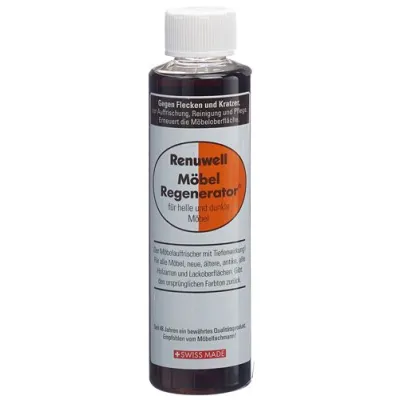The Secret to Spotless Furniture: Swiss-Quality Furniture Care Without Silicone
With proper care of furniture, you will preserve not only the aesthetic appeal of your items, but also their durability and inherent value. Any furniture, favorite antiques, modern centerpieces, is an investment in the comfort and beauty of your home.
Proper Furniture Care: Preserving Appearance and Durability
The appearance of furniture is the first thing that people pay attention to in any room. Dust, stains, and scuffs detract from its beauty and create a neglected look. Regular dusting with a soft, dry cloth prevents dust particles from settling on the surface and scratching the coating. For deeper cleaning, use products specially designed for the material of the furniture, be it wood, metal, glass or fabric. Prompt attention to spills and stains prevents permanent damage and keeps the furniture in good shape.
The durability of furniture largely depends on how well it is cared for. Environmental factors, such as direct sunlight, humidity, extreme temperatures, degrade the quality of materials over time. Avoid placing furniture in direct sunlight to prevent fading and warping, and maintain a stable environment to prevent expansion, contraction and brittleness of materials. Coasters and tablecloths also protect surfaces from heat, moisture and scratches, while periodic tightening of loose screws and joints prevents structural damage and extends the life of furniture.
Well-maintained furniture will not only last you longer, but also retain its value over time. This is especially true of antique or designer items, where originality and condition play a large role in their value. Regular care and preservation of the furniture's original finish and structure increases its appeal to collectors and ensures that it remains a valuable asset.
Special considerations
- Wood Furniture: Use special cleaners and polishes designed for wood to enhance its beauty and protect the finish. Avoid harsh chemicals that strip the coating.
- Upholstered furniture: Vacuum regularly to remove dust and allergens. Use fabric cleaners that are appropriate for the type of fabric and consider having stubborn stains professionally cleaned.
- Leather furniture: Clean with a soft, damp cloth and treat with leather conditioner to maintain elasticity and prevent cracking.
- Metal furniture: Wipe with a damp cloth and mild detergent, dry thoroughly to prevent rusting, especially outdoor furniture.
Issues with Silicone-Based Furniture Care Products
Silicone furniture care products are popular and create a shiny, smooth surface. However, the use of silicone-based products leads to problems that jeopardize the durability and integrity of the furniture. Here are the main disadvantages of silicone-based products:
- Accumulation and residue: with repeated use, silicone products leave a greasy film on the surface of the furniture and then attract dust and dirt, making it difficult to clean the furniture.
- Difficulty refinishing: Silicone residue is a problem when furniture needs a lab. Silicone seeps into the finish and into the wood itself and results in an uneven appearance that requires professional intervention to correct.
- Damage to certain coatings. silicone-based products will damage coatings that are oil-based or matte. Silicone reacts with these coatings, causing discoloration, clouding, and deterioration of the coating over time.
The Benefits of Silicone-Free Furniture Care Products
Natural and water-based furniture care products are beneficial for durability and aesthetic appeal. The main advantages of silicone-free furniture care:
- Safe for all finishes: Unlike silicone-based products, which damage finishes over time, silicone-free options are safe to use on all types of furniture finishes, including oil-based or varnished surfaces.
- Eco-Friendly: Many silicone-free furniture care products are made with natural, biodegradable ingredients. This minimizes damage to the environment and ensures that the air in the room is free of harmful chemicals.
- Easier finishing: furniture finished with silicone-free products is finished with less preparation and complications. Silicone residue does not need to be removed, which means that stains, paints and new coatings stick without problems.
Swiss-Quality Furniture Care Without Silicone
We draw your attention to Renuwell regenerator - a furniture care product that intensively cleans and cares for surfaces in a matter of seconds. Gray haze, dirt stains or small scratches are gently removed thanks to high-quality ingredients without silicone oil. Renuwell can be used on varnished surfaces, wood and linoleum. By the way, Renuwell möbel regenerator is a high-quality Swiss product, so you can be sure that you will receive a high-quality, reliable and effective product for the care of your furniture.
Renuwell furniture regenerator light dark fl 270 ml
Product Name: Renuwell Furniture Regenerator Light Dark Fl 270 ml Brand: Renuwell Restore your beloved furniture to its former glory with the Renuwell Furniture Regenerator Light Dark Fl 270 ml. Manufactured by the renowned brand, Renuwell, this regenerating fluid is expertly crafted to penetrate deep into your furniture, rejuvenating its look and extending its lifespan. Features: Volume: The 270 ml bottle provides enough fluid for multiple uses, ensuring long-lasting care for your furniture. Light Dark Formula: Perfect for both light and dark furniture, the Renuwell Furniture Regenerator seamlessly blends into any color, reviving its original shine. Deep Cleaning: The regenerator fluid penetrates deep into the wood, lifting dirt and grime from the pores, resulting in a thorough clean. Easy to Use: The easy-to-apply formula allows for quick and efficient application, making it suitable for busy homeowners and professionals alike. Benefits: Restores Shine: The Renuwell Furniture Regenerator revives dull and lifeless furniture, returning the original luster and shine. Extends Furniture Lifespan: By cleaning and nourishing the wood, the regenerator fluid can significantly extend the lifespan of your furniture, saving you from costly replacements. Improves Room Aesthetics: Restored furniture can drastically improve the aesthetics of your home or office, creating a more comfortable and inviting space. Use Cases: Home Use: Ideal for homeowners looking to revive their cherished furniture pieces, adding a touch of elegance to their living spaces. Professional Use: Perfect for professional cleaners and restorers, the Renuwell Furniture Regenerator provides a high-quality solution for their clients' furniture restoration needs. Office Use: Offices can greatly benefit from this product, extending the life of office furniture and maintaining a professional and clean environment. ..
19,15 USD
Also, another highly effective furniture care product is Renuwell Timber 100%, which is made from vegetable and 100% natural raw materials. The tool is suitable for all types of wood: raw, waxed, oiled and varnished. To use, you need to rub the surface, leave it for 2-3 hours, and if necessary, polish it. Untreated wood darkens a little. As a result, the product creates a silky matte shine, and the wood looks brighter.
Renuwell wood butter 100% natural jar 250 ml
Product Name: Renuwell Wood Butter 100% Natural Jar 250 ml Brand / Manufacturer: Renuwell Discover the magic of authentic wooden surfaces with Renuwell Wood Butter. This 100% natural solution is all you need to restore, protect, and enhance the beauty of your wooden furniture and items. Supplied in a generous 250 ml jar, this product offers an eco-friendly and effective way to maintain your wooden surfaces. Features: 100% Natural: Made entirely from natural ingredients, Renuwell Wood Butter is free from harsh chemicals, making it safe for you and the environment. High Volume: Comes in a large 250 ml jar, offering superb value for money and ensuring you have plenty for multiple applications. Easy to Apply: The butter-like consistency makes application a breeze. Simply spread it onto the surface and let it work its magic. Effective Restoration: It effortlessly removes dirt, grime, and old polish, restoring the natural beauty of your wooden surfaces. Benefits: Protection: Renuwell Wood Butter provides a protective layer, guarding your wooden surfaces against everyday wear and tear. Natural Shine: It enhances the natural colour and grain of the wood, bringing out its inherent beauty and shine. Long-lasting: A single application lasts for a long time, ensuring your surfaces remain looking their best. Use Cases: Home Furniture: Ideal for tables, chairs, cabinets, and all other wooden furniture in your home. Outdoor Furniture: Perfect for treating outdoor furniture, offering protection from the elements. Antiques: Safe to use on antique furniture, helping to restore and preserve its original charm. With Renuwell Wood Butter, you can enjoy the look and feel of new furniture without the cost. Treat your wood to the care it deserves with this 100% natural, high-quality product...
24,69 USD
Furniture Care Application Techniques
With the correct use of furniture care products, you will achieve the best results in cleaning, polishing and protecting your furniture. Each step in the process requires special techniques to ensure that the furniture not only looks its best, but also preserves it for future generations.
- Dust first: Always start by dusting your furniture with a soft, lint-free material or microfiber fabric to put off dirt and debris from the surface. This prevents scratches on the surface in the course of cleaning.
- Choose the proper cleansing agent: Choose a cleansing agent that is appropriate for the material of your furnishings. Use a timber cleanser for wood furnishings, a leather-based cleaner for leather-based items, etc. Always test the purifier on a small, inconspicuous area first.
- Applying with a soft cloth: Apply the detergent to a soft material, now not immediately to the furnishings. This helps control the amount of product used or even distribution.
- Choose the proper polish: Choose a polish that fits the finish of your furniture. For example, use beeswax polish to finish natural wood.
- Even application: gently rub the polish into the furniture in a round motion, moving along the grain of the wooden. This will allow the varnish to penetrate evenly and get a clean coating.
- Polish to a shine: Allow the polish to take a seat for a couple of minutes (take a look at the product instructions for precise times), then buff the surface with a clean, soft material to create a shine. Use a circular motion and rotate the fabric often to avoid redepositing any residue.
Disclaimer: While we try to offer valuable information on furnishings care using silicone-free products, we advise which you seek advice from a furnishings care expert or the producer before the use of any new product on your furnishings, in particular if it is vintage, has a unique processing or product of delicate materials.
L. Baumann












